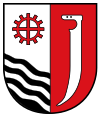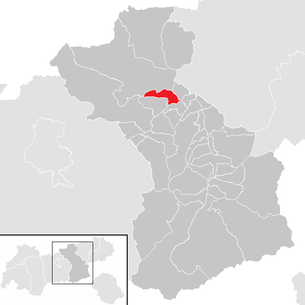Jenbach
|
market community Jenbach
|
||
|---|---|---|
| coat of arms | Austria map | |
|
|
||
| Basic data | ||
| Country: | Austria | |
| State : | Tyrol | |
| Political District : | black | |
| License plate : | SZ | |
| Surface: | 15.28 km² | |
| Coordinates : | 47 ° 24 ' N , 11 ° 47' E | |
| Height : | 563 m above sea level A. | |
| Residents : | 7,230 (January 1, 2020) | |
| Postal code : | 6200 | |
| Area code : | 05244 | |
| Community code : | 7 09 17 | |
| NUTS region | AT335 | |
| UN / LOCODE | AT JEN | |
| Address of the municipal administration: |
Südtiroler Platz 2 6200 Jenbach |
|
| Website: | ||
| politics | ||
| Mayor : | Dietmar Wallner ( ÖVP ) | |
|
Municipal Council : (2016) (19 members) |
||
| Location of Jenbach in the Schwaz district | ||
 Jenbach municipal office |
||
| Source: Municipal data from Statistics Austria | ||
Jenbach is a market town with 7230 inhabitants (as of January 1, 2020) in the Schwaz district in Tyrol ( Austria ). The community is located in the judicial district of Schwaz .
geography
location
Jenbach is located in the Lower Inn Valley 36 km east of the regional capital Innsbruck between the foothills of the Karwendel Mountains and the Rofan Mountains , south of the Achensee . In terms of tourism, Jenbach is part of the Karwendel silver region.
Neighboring communities
Buch in Tirol , Eben am Achensee , Stans , Wiesing
climate
|
Average monthly temperatures and rainfall for Jenbach
|
|||||||||||||||||||||||||||||||||||||||||||||||||||||||||||||||||||||||||||||||||||||||||||||||||||||||||||||||||||||||||||||||||||||||||||||||||||||||||||||||||||||||||
Community structure
The municipality consists of only one village (residents as of January 1, 2020):
- Jenbach (7230)
The former village of Fischl is no longer designated as a village in 2019.
etymology
It is often assumed among locals that the place name derives from "Beyond the stream" due to the similar wording. As early as 1269 a Svirid of "Ympach" is mentioned, which is the oldest mention of the place. An earlier name of Jenbach was, for example, Ünpach, which probably refers to the estate of H. von Unpach and is mentioned as early as 1427. Between 1350 and 1500 the place is called under "Uenpach", "Umpach" or "Uonpach". Since the name was pronounced “í-empach” in the dialect of the middle Inn Valley, the falling twosome was reproduced with ie as ever. This resulted in today's Jenbach debate. There are three different interpretations of the place name: According to the name researcher Karl Finsterwalder, the place name could go back to a personal name . Serfs of a monastery that had estates in Jenbach and Aibling in Bavaria could have moved from Upper Bavaria to Tyrol. The syllable "Uon" - referred to people who owned a stream. These people, who have relocated, could have brought the name stem Uon- with them. The art historian Erich Egg assumes that the hamlet “im (am) Bach” was called “Ympach” because of its location. The historian Otto Stolz thinks that the Kasbach in its lower reaches was called "Impach" from the 15th century and "Jenbach" from the 18th century. However, a clear determination of the origin cannot be made.
history
Prehistory and early history
In Jenbach, settlements from the end of the early Bronze Age and from the early La Tène period were found .
First mention and Middle Ages
Jenbach was first mentioned in a document from 1269. From 1410 smelting works for the smelting of silver and copper from the Schwazer Erzberg were built in Jenbach - under the leadership of the Fugger .
Modern times
After the ore wealth at Schwaz had dried up and the copper and silver works were closed, an iron works was operated from 1685 . This was 1773/74 up to one-third share of the Aerar passed; In 1865 the state became the sole owner. In 1870 the hut was sold to the "Salzburg-Tiroler-Montangesellschaft". In 1881 Julius & Theodor Reitlinger bought the plant for 75,000 guilders on the third attempt from this company and modernized it. Among other things, a cable car was built to transport ore to the rakes . From 1916 Julius' son, Friedrich Reitlinger , took over the business.
time of the nationalsocialism
In 1938, following Friedrich Reitlinger's suicide, in the course of the Anschluss, the plant was initially owned by the state and was sold to Ernst Heinkel in 1939 ( “Aryanized” ).
Second World War
On February 22, 1945, as part of the Allied Operation Clarion (German: Fanfarenschlag), six B-24 Liberator bombers dropped around 12 tons of bombs on the primary target, the freight yard, to prevent movements of the Reichsbahn (e.g. troop supplies) in Germany and Prevent Austria for the impending invasion. Five days later, during the second bombing raid at 2:20 p.m., seven B-24 bombers of the 12th US Air Force dropped around 19 t of bombs back onto the station and onto the grounds of the Scythe Union, which was not economically significant. Presumably their large premises were confused with the local and strategically important Heinkel aircraft factories . Heinkel in Jenbach supplied accessories for the Me 163 rocket fighter , the V1 flight bomb and the V2 rocket. Jenbach train station was only an alternative target for the air raid on Augsburg. Eight people were killed and 35 houses were damaged, some seriously. In April 1945, in front of the French Liberation Army (CC1 to CC5) under General Charles de Gaulle, which was advancing rapidly in southern Germany, more and more scattered SS units, including Heinrich Himmler's General Staff , poured into Jenbach and sought protection in the Alpine valleys in the allegedly existing " Alpine fortress ". Just by the sheer number and their fanatical determination to “fight to the last bullet”, they spread fear and terror in the village. On April 20, 1945, the last heavy air raid took place, a combination of gunfire from medium bombers of the 75th Wing of the USAAF and bombing from "flying fortresses" Boeing B-17 , which luckily did not result in personal injury.
Post-war until today
The Heinkel works were not restituted after 1945 , but remained under "public administration" until 1955. In 1959 the "Jenbacher Werke Aktiengesellschaft" was founded, which was listed on the Vienna Stock Exchange. The company now manufactured locomotives and diesel engines , among other things . In 1998 there was a change of ownership and a name change to "JENBACHER AG". In 2003 the AG was taken over by General Electric (GE). The current "GE Jenbacher AG" is the world market leader in the manufacture of gas engines for decentralized power generation and combined heat and power plants (CHP) in the range from 0.3 to 3 MW (megawatts).
In 2006 the municipality joined the Tyrolean Climate Alliance .
Population development

Culture and sights
Parish partnership
-
 Posina has been Jenbach's first partner church since 2017.
Posina has been Jenbach's first partner church since 2017.
economy
The place has economic importance today through the GE Jenbacher , Siko Solar, TIWAG , Katzenberger, Gubert (concrete) and Holz Binder . In the 20th century, Jenbacher Werke produced railway wagons, diesel locomotives, compressors and the like. v. a. Today, GE Jenbacher practically only produces combined heat and power units or gas engines and exports them all over the world. Siko Solar and TIWAG deal with energy. Katzenberger and Gubert produce concrete and precast concrete parts. Holz Binder mainly produces laminated beams for roof structures. The "Kasbach" is used to supply some small power plants with electricity.
education
- HTL Jenbach for building technology, mechanical engineering and industrial engineering
- NMS Jenbach
traffic
The Jenbach railway station is Express train stop and has a special railway lines in three different gauges :
- 1435 mm ( standard gauge ) of the ÖBB main line ( Unterinntalbahn )
- 1000 mm of the Achenseebahn
- 760 mm of the Zillertal Railway
Personalities
- Anton Blünegger (* 1940), politician, councilor in Jenbach
- Klaus Dona (* 1949), cultural manager, publicist, curator
- Alois Grauss (1890–1957), politician
- Sigmund Haffner (1699–1772), politician
- Roland Hattenberger (* 1948), football player
- Alois Leitner (1924–2018), politician and farmer's union director
- Wolfgang Meixner (* 1961), historian
- Simon Moser (1901–1988), philosopher
- Stanislaus Moser (1922–2001), teacher, founder and director of the Polytechnic Course in Jenbach, parish councilor
- Johann Georg Obrist (1843–1901), philologist, teacher and poet
- Ernst Pfretzschner (1882–1943), architect
- Norbert Pfretzschner (1850–1927), sculptor and writer
- Norbert Pfretzschner senior (1817–1905), politician and inventor
- Pirmin Pockstaller (1806–1875), Abbot of St. Georgenberg-Fiecht
- Hans Pontiller (1887–1970), sculptor
- Friedrich Reitlinger (1877–1938), industrialist, works manager at Jenbacher Werke
- Ernst Schmid (* 1958), writer
- Kathrin Schweinberger (* 1996), cyclist
Web links
- History-Tyrol: Jenbach
- Information from the local tourism association about Jenbach
- 70917 - Jenbach. Community data, Statistics Austria .
Individual references and source
- ↑ tirol.orf.at
- ↑ a b Statistics Austria: Population on 1.1.2020 by locality (area status 1.1.2020) , ( CSV )
- ^ Karl Finsterwalder: Name history of Jenbach. In: Jenbacher book. Contributions to the local history of Jenbach and the surrounding area. (Schlern-Schriften 101), Innsbruck 1953, pp. 75–84.
- ^ The market town of Jenbach. Parish book. Ed. Vd Marktgemeinde Jenbach, Schwarz: berenkamp, 1996, ISBN 3-85093-026-2 , p. 84 " History of the name"
- ↑ Thomas Albrich, Arno Giesinger: In the bomb war, Tyrol and Vorarlberg, 1943–1945. 1992, ISBN 3-85218-087-2 , p. 244.
- ↑ Thomas Albrich, Arno Giesinger: In the bomb war, Tyrol and Vorarlberg, 1943–1945. 1992, p. 245.
- ^ Community chronicle of Jenbach
- ↑ Thomas Albrich, Arno Giesinger: In the bomb war, Tyrol and Vorarlberg, 1943–1945. 1992, p. 253.





